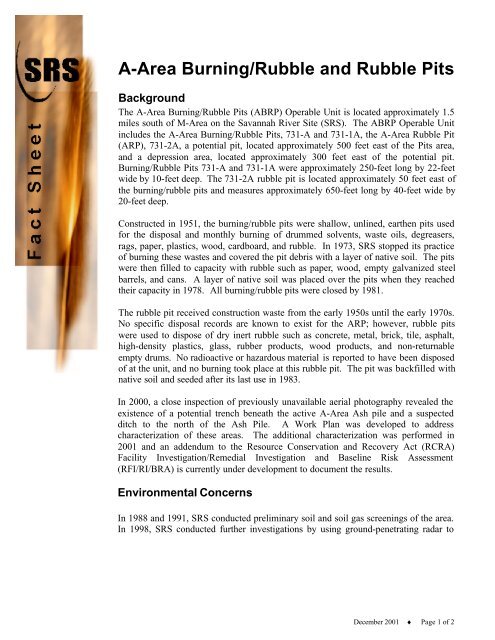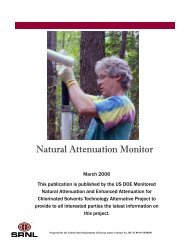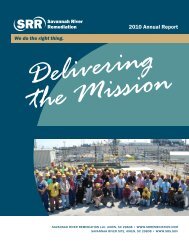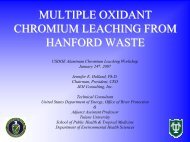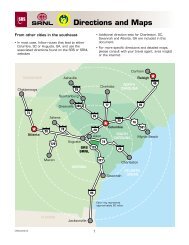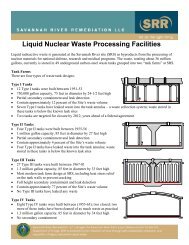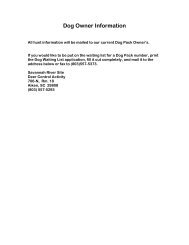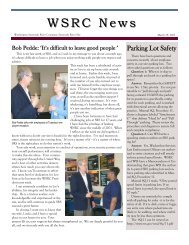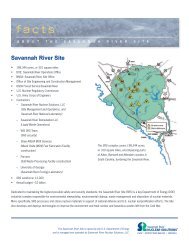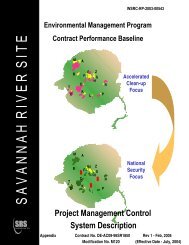A-Area Burning/Rubble and Rubble Pits - Savannah River Site
A-Area Burning/Rubble and Rubble Pits - Savannah River Site
A-Area Burning/Rubble and Rubble Pits - Savannah River Site
You also want an ePaper? Increase the reach of your titles
YUMPU automatically turns print PDFs into web optimized ePapers that Google loves.
A-<strong>Area</strong> <strong>Burning</strong>/<strong>Rubble</strong> <strong>and</strong> <strong>Rubble</strong> <strong>Pits</strong><br />
Background<br />
The A-<strong>Area</strong> <strong>Burning</strong>/<strong>Rubble</strong> <strong>Pits</strong> (ABRP) Operable Unit is located approximately 1.5<br />
miles south of M-<strong>Area</strong> on the <strong>Savannah</strong> <strong>River</strong> <strong>Site</strong> (SRS). The ABRP Operable Unit<br />
includes the A-<strong>Area</strong> <strong>Burning</strong>/<strong>Rubble</strong> <strong>Pits</strong>, 731-A <strong>and</strong> 731-1A, the A-<strong>Area</strong> <strong>Rubble</strong> Pit<br />
(ARP), 731-2A, a potential pit, located approximately 500 feet east of the <strong>Pits</strong> area,<br />
<strong>and</strong> a depression area, located approximately 300 feet east of the potential pit.<br />
<strong>Burning</strong>/<strong>Rubble</strong> <strong>Pits</strong> 731-A <strong>and</strong> 731-1A were approximately 250-feet long by 22-feet<br />
wide by 10-feet deep. The 731-2A rubble pit is located approximately 50 feet east of<br />
the burning/rubble pits <strong>and</strong> measures approximately 650-feet long by 40-feet wide by<br />
20-feet deep.<br />
Constructed in 1951, the burning/rubble pits were shallow, unlined, earthen pits used<br />
for the disposal <strong>and</strong> monthly burning of drummed solvents, waste oils, degreasers,<br />
rags, paper, plastics, wood, cardboard, <strong>and</strong> rubble. In 1973, SRS stopped its practice<br />
of burning these wastes <strong>and</strong> covered the pit debris with a layer of native soil. The pits<br />
were then filled to capacity with rubble such as paper, wood, empty galvanized steel<br />
barrels, <strong>and</strong> cans. A layer of native soil was placed over the pits when they reached<br />
their capacity in 1978. All burning/rubble pits were closed by 1981.<br />
The rubble pit received construction waste from the early 1950s until the early 1970s.<br />
No specific disposal records are known to exist for the ARP; however, rubble pits<br />
were used to dispose of dry inert rubble such as concrete, metal, brick, tile, asphalt,<br />
high-density plastics, glass, rubber products, wood products, <strong>and</strong> non-returnable<br />
empty drums. No radioactive or hazardous material is reported to have been disposed<br />
of at the unit, <strong>and</strong> no burning took place at this rubble pit. The pit was backfilled with<br />
native soil <strong>and</strong> seeded after its last use in 1983.<br />
In 2000, a close inspection of previously unavailable aerial photography revealed the<br />
existence of a potential trench beneath the active A-<strong>Area</strong> Ash pile <strong>and</strong> a suspected<br />
ditch to the north of the Ash Pile. A Work Plan was developed to address<br />
characterization of these areas. The additional characterization was performed in<br />
2001 <strong>and</strong> an addendum to the Resource Conservation <strong>and</strong> Recovery Act (RCRA)<br />
Facility Investigation/Remedial Investigation <strong>and</strong> Baseline Risk Assessment<br />
(RFI/RI/BRA) is currently under development to document the results.<br />
Environmental Concerns<br />
In 1988 <strong>and</strong> 1991, SRS conducted preliminary soil <strong>and</strong> soil gas screenings of the area.<br />
In 1998, SRS conducted further investigations by using ground-penetrating radar to<br />
December 2001 ♦ Page 1 of 2
define the pit boundaries <strong>and</strong> by collecting soil borings. Soil at <strong>Rubble</strong> Pit 731-2A was found to be<br />
contaminated with benzo(a)pyrene (BaP).<br />
Groundwater monitoring of the ARP series wells was performed from 1984 through the fourth quarter<br />
of 1991, to characterize impacted secondary media. The groundwater beneath the area was found to be<br />
contaminated with volatile organics; namely trichloroethylene, tetrachloroethylene <strong>and</strong> methylene<br />
chloride.<br />
Environmental Actions <strong>and</strong> Plans<br />
In 1996, SRS submitted the RCRA RFI/RI/BRA Report for this Operable Unit to the U.S.<br />
Environmental Protection Agency (USEPA) <strong>and</strong> the South Carolina Department of Health <strong>and</strong><br />
Environmental Control (SCDHEC). The report was approved by the agencies in 1997. The<br />
RFI/RI/BRA identified trichloroethylene, tetrachloroethylene, <strong>and</strong> methylene chloride as groundwater<br />
constituents of concern; <strong>and</strong> it identified BaP as a constituent of concern in the surface soil at <strong>Rubble</strong> Pit<br />
731-2A.<br />
In 1997, SRS submitted a Record of Decision (ROD) to USEPA <strong>and</strong> SCDHEC that described the<br />
preferred alternative for remediating the Operable Unit. The ROD recommended installation of a onefoot<br />
thick soil cover over <strong>Rubble</strong> Pit 731-2A <strong>and</strong> implementation of institutional controls that would<br />
restrict the use of the l<strong>and</strong> to industrial activities <strong>and</strong> limit human exposure to the soil <strong>and</strong> groundwater.<br />
The ROD was not approved.<br />
In 1998, SRS submitted a new Operable Unit strategy to USEPA <strong>and</strong> SCDHEC, <strong>and</strong> in 1999, SRS<br />
submitted an Interim Record of Decision (IROD). The IROD was approved in 2000.<br />
The interim actions are as follows:<br />
• Groundwater – Installation of a combination of air sparging <strong>and</strong> passive soil vapor extraction<br />
(PSVE). The PSVE utilizes the SRS-patented BaroBall check-valve to remove contaminated soil<br />
vapor. A staged approach will be used to implement the groundwater remediation system. Stage 1<br />
consists of a combination of air sparge <strong>and</strong> PSV wells. Operational results from Stage 1 will be used<br />
to design the Stage 2 remediation system.<br />
• Surface Soil – Placement of a soil cover <strong>and</strong> implementation of institutional controls at the <strong>Rubble</strong><br />
Pit 731-2A. This constitutes the final remedy for the pit.<br />
Placement of the soil cover over <strong>Rubble</strong> Pit 731-2A <strong>and</strong> construction of the Stage 1 groundwater<br />
remediation system were completed in September 2001. Data obtained during the first year of operation<br />
of Stage 1 will be evaluated <strong>and</strong> utilized to augment the Stage 2 system approach.<br />
December 2001 ♦ Page 2 of 2


